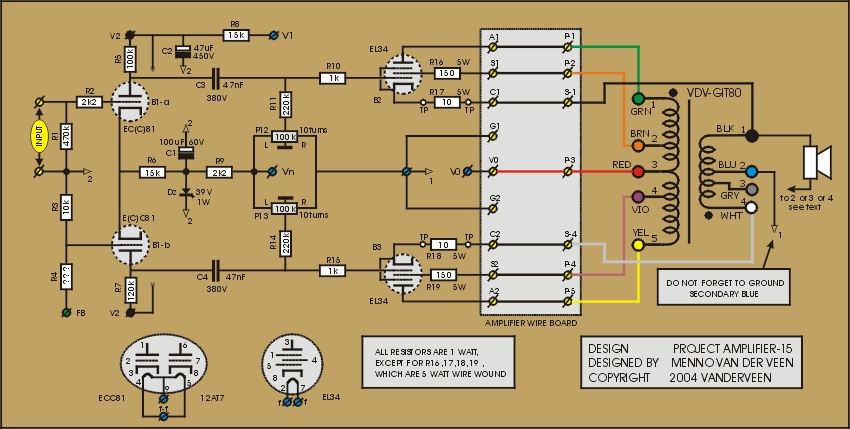In amplifier 15 the screen grids are connected to the ultra linear taps P-2 and P-4 of the output transformer. This means that almost the full output power of the power tubes is available. The cathodes again are connected to the secondary winding of the OPT. This creates extra local feedback. Click ![]() here to download the measurement results.
here to download the measurement results.
The sound character of amplifier15 is very open with lots of space and details. This is a real high quality high end amplifier. All instruments and voices are placed holographically in the sound stage with the right dimensions. The space between the instruments is not empty, but breathes the acoustic information of the environment. The deep and very well controlled low frequency reproduction is fantastic with many details. This dynamic reproduction allows you to listen deep into the acoustics of the recording. The details are clean and pure; they really contain the "emotional content" of the art of the human artists.
Now it is time to compare the amplifiers 12 and 15. They have almost equal damping factors and amplification. However, the output power of amp 15 is twice the power of amp 12. These specifications explain why I gave amp 15 its birth name "Super Triode". Also striking is the -3dB high frequency range. Amp 15 has almost twice the range of amp 12. It is the Miller capacitance that is causing this. The screen grids in amp 15 do not contain the complete anode alternating voltage, as is the case in amp 12. So, in amp 15 this Miller capacitance is smaller.
Going to the pure subjective evaluation where amp 15 shows control. He is less dynamic than amp 10 while they have the same output power. This aspect can be explained by looking at the damping factors. In amp 15 we have an almost complete voltage driven situation, while amp 10 is close to current drive. Under voltage drive (high damping factor) the movements of the cone of the loudspeaker are more controlled (this depend on the loudspeaker you use). The control creates less low frequency time smearing, which enables you to hear more details in the low frequencies. But there is always a "but". The next time amplifier 16 has even more bass control by its larger damping factor and this does not improve the bass reproduction. It appear as if there is a certain limit which I would like to discuss the next time.
Next time: amplifier 16

